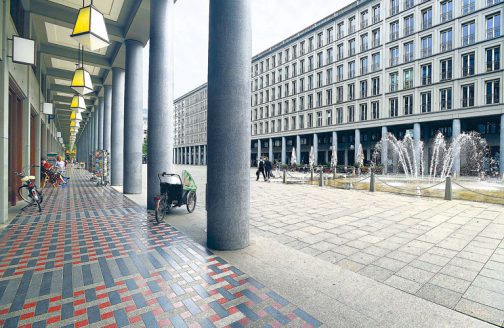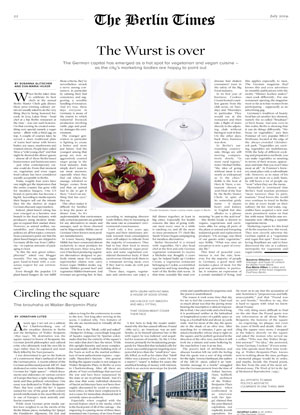Circling the square: The brouhaha at Walter-Benjamin-Platz

A week ago, I set out on a subway for Charlottenburg, one of the swankier districts in Berlin and the birthplace of Walter Benjamin (1892–1940). My destination was the square named in honor of Benjamin, the German Jewish philosopher and cultural critic who ultimately took his own life in 1940 rather than be captured and most likely killed by his Nazi pursuers.
I was determined to get to the bottom of a controversy that’s surfaced of late in the German press. A recent edition of the German architectural journal ARCH+ had dedicated an entire issue to Rechte Räume– German for “right spaces” – which documents and elaborates on various corners of Europe that have a right-wing architectural, and thus political, orientation. One essay was dedicated to Walter-Benjamin- Platz. But how could this be? A square named for one of the great 20th-century Jewish intellectuals in the most liberal city in one of Europe’s most ardently antifascist countries?
While most German print media outlets have weighed in on the merits of the Rechte Räume piece, including Der Spiegel, the Frankfurter Allgemeine, Die Zeit, and most Berlin dailies, few question that it’s taken so long for the controversy to come to the fore. Not long after arriving at the scene, I realized why. Two features of the site are mentioned in virtually all the reporting.
The first is the “bleak, cold and naked” (Stuttgarter Zeitung), exceedingly long pair of façades supported by Spartan colonnades that line the entirety of the square’s two sides that don’t face the street. While this upright linearity and stone complexion undeniably recall the building style of the Nazis as well as the martial architecture of most authoritarian regimes – especially Mussolini’s fascism – this general feeling the square exudes is not unique to Walter-Benjamin-Platz, in Berlin or even in Charlottenburg. After all, there are plenty of Nazi-era buildings that survived the war and have been repurposed by the state or are in private hands. And it’s also true that some individual elements of fascist architecture have not been thoroughly discounted by social or architectural critics, so their mere employment is not a cause for immediate dismissal, but it certainly raises an eyebrow.
Especially when coupled with the second feature cited in the media, which is the focal point of all of the outrage – the engraving in a paving stone of three lines, translated into German, of an Ezra Pound poem:
WITH USURA HATH NO MAN
A HOUSE OF GOOD STONE.
EACH BLOCK CUT SMOOTH
AND WELL FITTING,
THAT DESIGN MIGHT COVER
THEIR FACE.
A few facts to help the reader understand why this has caused offense: Pound (1885–1972), an American, was an anti- Semite, as he himself admitted late in life with regret; he was indicted (and acquitted for reasons of insanity) by the US for treason, primarily for broadcasting propaganda for Mussolini that included calls for a more successful pogrom targeting more powerful Jews than the “small Jews” usually killed, as well as his claim that “Adolf Hitler was a Jeanne d’Arc, a saint. He was a martyr”; “usura” is Italian for usury, the unethical lending of money with interest, which is an ancient stereotype for Jewish crime and a justification for pogroms; and, the poem is unattributed.
The reason it took some time that day for me to feel the controversy I had read so much about was that the paving stone bearing the inscription is almost impossible to find. One yard wide and a foot long, it is positioned neither at the latitudinal or longitudinal center of a public space as long as a football field and about 25 yards wide. And for most of the day, the quote sits in the shade of an olive tree. After searching for 10 minutes, I gave up and asked a bookseller, whose shop is right on the square, and he politely gestured in the direction of the olive tree, and then it still took me a minute and some hollering by the man before I saw it at my feet.
The poem’s lack of attribution and obscure location left me with the feeling that the quote was a sort of dog whistle for the right. Verena Hartbaum, the author of the ARCH+ piece, called it an “anti- Semitic message in a bottle” smuggled into the German present from the time of Italian fascism. Hans Kollhoff, the architect of the Walter- Benjamin-Platz project, when confronted in an interview with Der Spiegel, claimed that the poet blamed capitalism, not explicitly Jewish capitalists, for the world wars. He went on to say that the accusation of anti-Semitism is “preposterous and fully unacceptable,” and that “Pound was no anti-Semite.” Needless to say, this is hard to square with what we know about Pound.
The only thing more difficult to find on the site than the Pound quote was any information at all about Walter Benjamin, the honoree of the square – no engraving, no plaque, not even his years of birth and death. After circling the square once more, I stopped at the bakery directly on the square and asked the woman who served me a coffee: “Who was this Walter Benjamin anyway?” “No idea,” she answered, “some German, I reckon.” If even someone who spends most their time working at Walter-Benjamin-Platz knows next to nothing about the man, perhaps a memorial plaque would be in order, and maybe, beside the Pound poem, this line from the end of his most celebrated essay, The Work of Art in the Age of Mechanical Reproduction (1935):
ALL EFFORTS TO MAKE
POLITICS AESTHETIC
CULMINATE IN ONE THING: WAR.
Jonathan Lutes
is an editor of The German Times.




